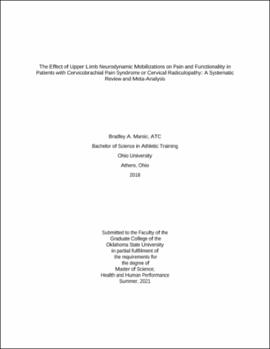| dc.description.abstract | Cervicobrachial pain syndrome (CBPS) and Cervical Radiculopathy (CR) can be caused by a multitude of various diagnoses and dysfunctional tissue structures. CBPS and CR signs and symptoms include but not limited to radiating pain into the upper extremities, muscular imbalances, tender or painful trigger points, numbness in the upper extremities, and inflamed neural tissue structures. However, the effects of upper extremity neurodynamic mobilizations (NM) use on relieving CBPS and CR symptoms has not been critically evaluated for effectiveness. The purpose of this systematic review and meta-analysis is to assess the level of evidence between multiple studies utilizing NM on upper extremity pain utilizing Visual Analog Scales (VAS), Numeric Pain Rating Scales (NPRS) or Numeric Rating Scale of Pain (NRSP), and Functionality using the Neck Disability Index (NDI) in participants with CBPS or CR, and whether NM provides a clinically beneficial effect. An extensive electronic search was performed utilizing the following databases: Medline (PubMed), Cinahl Plus, EBSCO Host, SPORTDiscus, Science Direct, Scopus, and Google Scholar. A statistically significant difference was seen for both control and intervention pre vs. post VAS scores; control (95% CI = 4.18 [3.37, 4.99], Z = 10.12 (P < 0.00001)), and intervention (95% CI = 2.47 [0.48, 4.66], Z = 2.41 (P = 0.02)). No statistically significant difference was seen for control pre vs. post NPRS/NRSP scores (95% CI = 2.77 [-0.45, 5.98], Z = 1.69 (P = 0.09)). A statistically significant difference was seen for intervention pre vs. post NPRS/NRSP scores (95% CI = 2.99 [1.40, 4.58], Z = 3.69 (P = 0.0002)). No statistically significant difference was seen for control pre vs. post NDI scores (95% CI = 1.34 [-0.08, 2.77], Z = 1.85 (P = 0.06)). A statistically significant difference was seen for intervention pre vs. post NDI scores (95% CI = 2.80 [1.12, 4.47], Z = 3.26 (P = 0.001)). Results from this systematic review and meta-analysis provide plausible data supporting the use of neurodynamic mobilizations as a therapeutic intervention for patients with CBPS and CR. However, with limited current research, and lack of true control group treatment studies, more research is needed to further enhance the quality and understanding of neurodynamic mobilizations as a therapeutic intervention. | |
